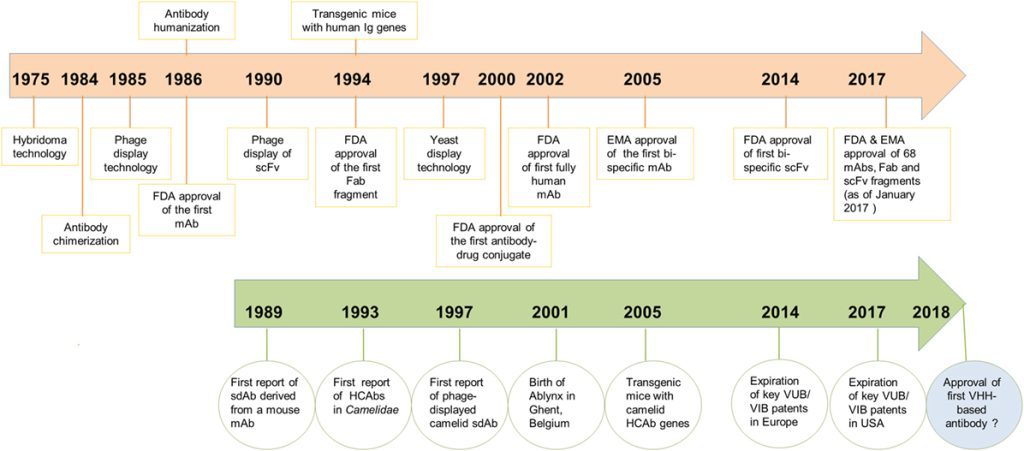VHH antibodies, also known as single-domain antibodies (sdAbs) or nanobodies, are a class of antibodies found in camels, llamas, alpacas, and other camelids. These unique molecules have revolutionized the field of antibody research due to their unique properties and potential applications for therapeutics.
Early Discoveries (1980s)
In 1989, the lab of Professor Raymond Hamers-Casterman at the Vrije Universiteit Brussel (VUB) in Belgium was studying the immune system of camels. The team made a serendipitous discovery, observing an unusual type of antibody molecule in Trypanosoma evansi-infected dromedary camel blood that was much smaller than the conventional antibodies found in humans and other mammals. These smaller antibodies lacked the CH1 domains required for light chain pairing in traditional antibodies. Therefore, they consisted solely of the variable domain of the heavy chain, but still displayed a remarkable ability to bind to a large range of antigens.1
Unlocking the Potential (1990s)
The 1990s witnessed significant progress in VHH research. Scientists successfully isolated and characterized VHH antibodies from camels immunized with specific antigens, with the first VHH sequences published in 1996, and subsequent cloning and expression. This breakthrough paved the way for exploring the unique properties of VHHs. Researchers discovered that VHHs possessed several advantages over conventional antibodies:
- Smaller size: Due to their single-domain structure, VHHs are significantly smaller than traditional antibodies. This allows them to penetrate deeper into tissues and access cavities inaccessible to bulkier antibodies.
- Higher stability: VHHs exhibit remarkable stability under harsh conditions like high temperatures and extreme pH. This makes them ideal for applications requiring robust molecules.
- High affinity and specificity: VHHs can bind to their target antigens with high affinity and specificity, making them valuable tools for diagnostics and targeted therapies.
Commercialization and Beyond (2000s – Present)
The turn of the millennium saw the commercialization of VHH technology, with issues for patents for VHH discovery and production. Investment in VHH antibodies for therapeutic use is increasing, leading to more preclinical and clinical trials. Today, scientists are utilizing VHHs in various fields, including:
- Drug discovery: VHHs serve as potent tools for identifying and targeting disease-causing molecules.
- Diagnostics: VHHs can be engineered to detect specific biomarkers associated with various diseases.
- Biotechnology: VHHs are being explored for targeted drug delivery and bioimaging applications.
The Future of VHH Antibodies
The future of VHH antibodies holds immense promise. With ongoing research and development, VHHs have the potential to revolutionize various fields like medicine, biotechnology, and materials science. Their unique properties make them valuable tools for creating next-generation diagnostics, therapeutics, and bioengineered products. As research continues to unravel the full potential of VHHs, we can expect even more exciting discoveries and applications in the years to come.
- Odongo, S., Radwanska, M., & Magez, S. (2023). Nanobodies: A Review of Generation, Diagnostics and Therapeutics. International Journal of Molecular Sciences, 24(6). https://doi.org/10.3390/ijms24065994

